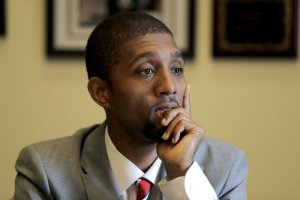
Brandon Scott, one of the youngest Baltimore City mayors, ran on a platform to modernize the city government. In order to rebuild public trust and government accountability, Mayor Scott has instituted new positions and reworked the structure and practice of city government. (AP Courtesy Photo)
By Ralph E. Moore Jr.
Rmoore@afro.com
And Megan Sayles, AFRO Business Writer
Report for America Corps Member
msayles@afro.com
Renaissance. It’s not a new term to Baltimore. First there was The Great Baltimore Fire of 1904 that completely ravaged 1,500 buildings and damaged another 1,000. Some estimates put the loss of property at $100 million, and yet Baltimore came back. Then there was the promise of two harborside pavilions for eating, shopping and socializing with the 1980 birth of Harborplace heralded as the revival of downtown Baltimore. Citizens were promised tourist dollars would rain down like manna from heaven to improve our little town… And yet some here still look to the government wondering when it will rain.
Mayor Thomas D’Alesandro III served as the 43rd mayor of Baltimore from 1967 to 1971. Not long into his term, Martin Luther King was assassinated and Baltimore, like American cities everywhere, was racked with riotous pain. D’Alesandro, a Caucasian, was unusually popular in Baltimore’s 46% African-American community. For example, he once implemented a housing program to finance 475 of the vacant homes abandoned after they were previously condemned to create “homes for the poor,” according to Jessica Elfenbein, Thomas L. Hollowak and Elizabeth Nix’s book “Baltimore ’68 : Riots and Rebirth in an American City.”
He met Martin Luther King Jr. at the minister’s request, and they discussed the details of an open housing civil rights bill pending in the City Council. D’Alesandro and King developed a friendship. The mayor was committed to racial justice, and it showed in how he governed. D’Alesandro appointed the first Black city solicitor in Baltimore history and first Black in a mayor’s cabinet.
After only one term, D’Alesandro was succeeded by William Donald Schaefer. His leadership style was to push city government to perform at its highest level. “Do it now!” was his rallying cry and he might have preferred more to be feared than loved.
Schaefer named Bishop L. Robinson as the Baltimore City Police Department’s first African-American police commissioner, a plus to many. But he also created a $100 million loan and guarantee bank for developers that some say he used as his personal slush fund to favor certain developers of businesses in our area. There were no applications for loans and no banking hours, just Mayor Schaefer and his whims.
The Baltimore City government was headed by its first Black mayor in the person of Clarence H. Du Burns in 1987 due to Schaefer’s rise to governor. The first elected Black mayor of Baltimore was Kurt L. Schmoke, elected later in 1987.
City government was segregated at the top until 1966 when Victorine Adams was elected as the first Black woman to City Council, a full 76 years after Harry Sythe Cummings was elected as the first Black man. Up until modern times, city government was segregated by race and gender. Mary Pat Clarke was the first female president of the City Council in 1987, and Sheila Dixon was the first Black female mayor in 2007.
A referendum in 2002 changed the City Council structure from 6 districts represented by three representatives each to 14 single member districts.
But, mayors come and go. Administrations come and go with them with changes of little substance most terms but vast differences in governing styles.
The latest change of the guard was in Mayor Brandon Scott’s 2020 election. At age 36, he became the youngest person to hold this office in over 100 years. In a city where leadership has experienced recent scandals and corruption, Mayor Scott decided that he needed to abandon the status quo of past administrations.
“When you’ve seen the good, the bad and the ugly of city government as I have since I’ve been in city government since I was 23 years old, it provides an opportunity for you to improve upon things that have worked but could work better and to stop doing things that haven’t worked,” said Mayor Scott. “Also, you can consistently be in a state of evolving and evaluation.”
A significant part of Mayor Scott’s platform concerned modernizing city government’s structure and practices. Before his election, Baltimore City was one of the few major cities in the country and one of the few jurisdictions in Maryland that did not have a city administrator or similar position, according to Mayor Scott. Christopher Shorter became the first person to assume this position in 2021, and he serves as a politically neutral executive that oversees government action.
With modernization comes a call for a greater focus in technology. Mayor Scott’s appointments of Chief Data Officer Justin Elszasz and Director of Broadband and Digital Equity Jason Hardebeck have created a data-driven city government that expands on what former administrations have done by monitoring vaccinations, COVID-19 cases, budgeting, crime and the digital divide. His Open Checkbook platform that was published earlier this year has allowed the government to be more transparent with the public about city spending.
“Everyone knows that data is important, and it’s really the cornerstone of good governance,” said Mayor Scott. “If you can’t measure it, you can’t improve it.”
One other notable appointment that Mayor Scott made was Baltimore’s first Chief Equity Officer Dana Petersen Moore. He said looking at the blatant racial and economic disparities that have long tormented the city, there was a need for someone to ensure that the government is operating through a lens of equity.
Mayor Scott also transformed the way that city officials and residents view crime in Baltimore. His new crime plan looks at violence as a public health issue, which is why he said he rebranded the Mayor’s Office of Criminal Justice to the Mayor’s Office of Neighborhood Safety and Engagement. Police must focus on the most violent groups, like gun traffickers, according to Mayor Scott. Calls that regard substance abuse and mental and behavioral problems must be diverted to health experts.
“When folks think about all of these changes and whether folks like the new system, the reality is that true leadership requires the courage to do the right thing even when it’s not popular,” said Mayor Scott.
Help us Continue to tell OUR Story and join the AFRO family as a member – subscribers are now members! Join here!
The post Baltimore City is always being reimagined appeared first on AFRO American Newspapers .











